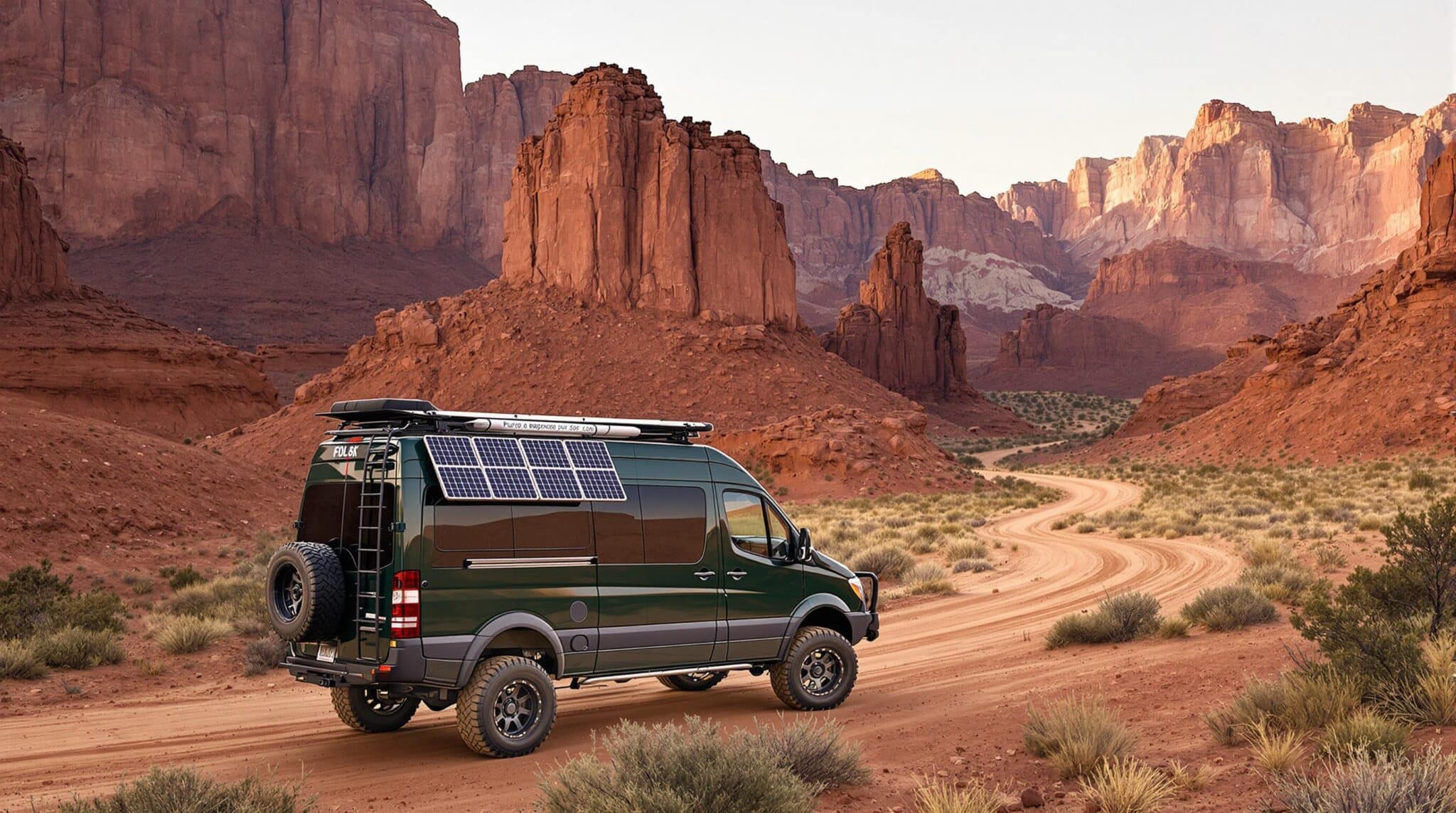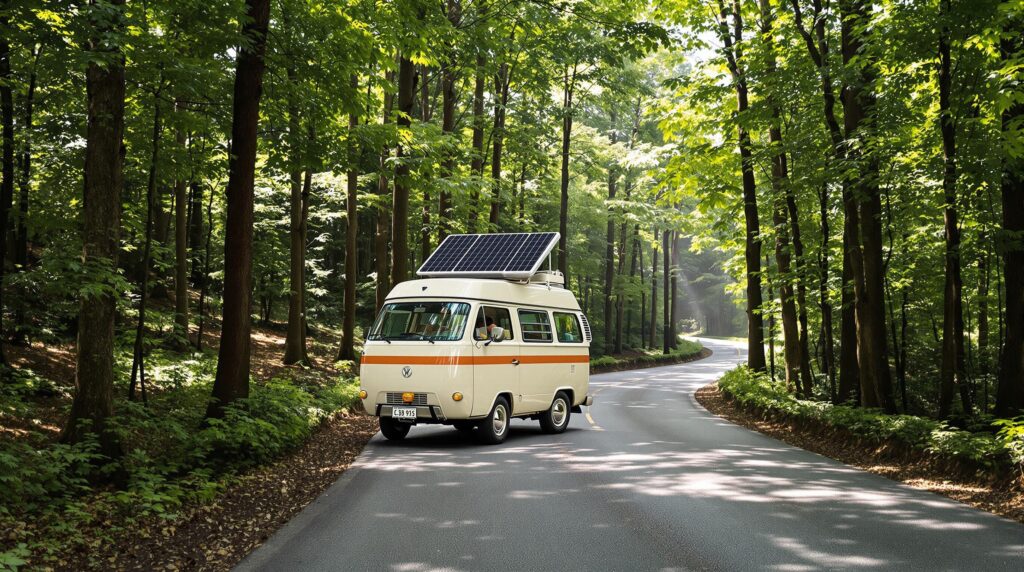Tired of searching for power outlets while camping or relying on the grid for your van ?
A van solar kit is the ideal solution to gain energy autonomy and fully enjoy your adventures on the road.
Discover how this guide will help you choose, install, and optimize your solar kit , with key tips for a successful solar panel installation and reliable energy wherever you are.
To remember
- Rigid monocrystalline panels are more resistant and ensure optimal production even in low light.
- Choose a kit that suits your energy needs
- An MPPT regulator is important : it can improve conversion by up to 30% compared to a PWM
- Want complete autonomy? A battery will be essential
Understanding the solar van kit and its main components
A solar van kit converts the sun’s energy into usable electricity. It allows you to avoid outdoor electrical outlets and enjoy autonomy in the great outdoors .
Travelers benefit from clean, free energy for their devices. They avoid dependencies on electricity and can stop wherever they want. This significantly increases their freedom.
A complete kit includes panels, an MPPT regulator, an auxiliary battery and connection cables. Each element plays a specific role in capturing, storing and using solar energy .
| Component | Main role | Technical characteristics |
|---|---|---|
| Solar panel | Transforming light into electricity | High-efficiency monocrystalline models – Available in rigid or flexible versions – Suitable for tight spaces |
| MPPT regulator | Optimize battery charging | 30% higher efficiency than conventional models – Works in extreme temperatures – Settings adapted to different battery types |
| Auxiliary battery | Conserve the captured energy | Lithium technology recommended for its longevity – Compatible with standard chargers – Capacity adapted to expected consumption |
| DC-DC charger | Recharge from the vehicle’s alternator | Compatible with recent standards – Current adjustment according to needs – Additional autonomy on the move |
| Waterproof roof hatch | Protect against infiltration | Leak-proof design – Fits standard cables – Withstands prolonged weather conditions |
| Inverter (optional) | Convert 12/24V current to 230V | Variable power according to needs – Requires careful installation – Efficiency to be optimized with short wiring |
The panels are divided into rigid, flexible, or monocrystalline. Each adapts to specific needs and the configuration of the van’s roof.
To choose your solar panel, here are the available options:
- Monocrystalline solar panel : very efficient for limited roof space
- Flexible solar panel : adaptable to curved roofs but reduced lifespan
- Foldable solar panel : transportable but bulky to store
- Polycrystalline solar panel : cheaper but less efficient than monocrystalline models
The power depends on the devices installed in the van. A simple calculation adds up the daily consumption of each electronic device to determine the ideal system size .
Refrigerators, lighting, and cooking systems consume the most energy. You should plan for a solar kit sufficient to cover these daily energy needs, with a safety margin for cloudy or sunless days.
How to choose the best solar panel for your van ?
Overview of the key criteria to consider when choosing a solar kit for a van
The power of the panels, their technology (monocrystalline, polycrystalline) and the space available on the roof guide the choice . The quality of the components such as the MPPT regulator and the warranty period (25-30 years) also influence the performance.
Choose back-contact monocrystalline panels (24% efficiency) or half-cut to resist shade. An MPPT regulator improves charging by 20 to 30%. Check compatibility with your auxiliary battery for an optimized system .
Discover our comparison of van solar kits
Tips for evaluating value for money and avoiding common mistakes when buying a solar kit
Prioritize durability over low prices. A quality kit avoids hidden costs associated with frequent maintenance. Check brand reviews and reliability rather than relying on a used product without a warranty.
Calculate your energy needs before purchasing. A 100W panel produces about 40Ah/day in summer, enough for a small refrigerator (like the Ecoflow Glacier ) and electronic devices . Polycrystalline, 30% cheaper, is suitable for tight budgets but with a lower efficiency (14-16%).
Cost and profitability of a solar kit for a van
Presentation of the price ranges of solar kits according to their power and components
Basic kits (100W) start at $249. Complete models (500W) with battery cost over $4,000. The power and quality of the panels directly influence the price .
A simple 185W kit costs around $420. With a battery, a 255W reaches $2000.
Integrating a battery increases the cost by 3 to 5 times . Monocrystalline models are 40% more expensive than polycrystalline ones.
Analysis of the long-term profitability of a solar van installation compared to other power solutions
Solar kits pay for themselves in 2 to 5 years for regular travelers. A $1,500 system pays for itself in 4-5 years with 200 overnight stays spent camping annually (savings of $3-7/night).
Over 20 years, the lifespan of the panels ensures stable savings . A lithium battery lasts 10-15 years, limiting replacements. Compared to a generator, solar avoids recurring fuel and maintenance costs.
Installation and optimal use of a solar kit
Key steps to installing a solar kit on your van
Installation begins with choosing a kit that suits your needs. Lay the panels dry to check the placement. Drill holes in the roof for the cables, apply sealant around the waterproof cable gland, and then secure the panel according to the manufacturer’s instructions .
To fix the roof, carefully clean it. Use Z-type brackets or rails with UV-resistant adhesive. The space around the panels (approximately 75 mm) makes fixing easier. Always check for leaks before finalizing the installation.
Electrical System Connection and Configuration
Connect the panels to the MPPT controller, then connect the MPPT controller to the auxiliary battery. The controller optimizes charging by automatically adjusting to the battery voltage. Short wiring limits energy losses.
Set the MPPT controller according to the battery type (lead, lithium). Manual setting is sometimes necessary. The connection order (panels → controller → battery) prevents configuration errors and ensures smooth operation .
Maintenance and optimization of energy production
Clean the panels with warm water and a soft sponge, avoiding chemicals. Unplug them before cleaning. Biannual maintenance (spring and fall) preserves up to 7% additional production .
To maximize the captured energy:
- Position the van facing the rising sun for optimal exposure.
- Charge mainly between 10am and 4pm, when the light is strong.
- On cloudy days, prioritize essential appliances to save energy.
- Clean the panels regularly to avoid a loss of 5 to 15% in efficiency.

Complementary solutions for total autonomy
Presentation of complementary systems to combine with a solar kit for complete autonomy
For maximum autonomy, combine solar power with other sources. The vehicle’s alternator recharges the battery while driving. Portable generators serve as a backup in an emergency. These options complement solar power in all conditions.
Comparison of different energy autonomy solutions for vans
| Solution | Benefits | Disadvantages |
|---|---|---|
| Solar | Free, silent and ecological energy | Weather dependent |
| Alternator | Effortless charging on the go | Fuel consumption |
| Generator | Immediate autonomy in any situation | Noise, maintenance and fuel costs |
Solar power remains the basis for its eco-friendly side. The alternator is ideal for traveling. The generator remains an emergency solution for sunless days or occasional needs.
Equipping your van with a solar kit combines energy autonomy, ease of installation, and long-term savings. By adapting the power of the solar panels to your needs and optimizing storage in an auxiliary battery, each traveler gains freedom. Why wait? The sun’s energy transforms your campervan into a self-contained refuge , ready to explore the unknown without compromise.
FAQ
What is the price of a solar panel for a van?
The price of a solar panel for a van generally ranges between $100 and $400 depending on the power (between 100W and 300W), the technology (monocrystalline or polycrystalline), and the quality. In addition, you often need to consider the cost of the charge controller, wiring, and possibly the battery if you don’t purchase a complete kit.
What is the best type of solar panel for a van?
The best choice for a van is often a rigid monocrystalline solar panel, as it offers excellent efficiency even in low light conditions and is durable over time. Brands like Victron, EcoFlow, or Sunpower are particularly renowned for their reliability and performance in mobile setups.
